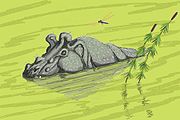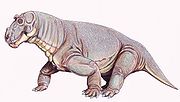
Estemmenosuchus
Encyclopedia
Estemmenosuchus is a genus
of large, early omnivorous
therapsid that lived during the middle part of the Middle Permian
period. It was among the largest animals of its day, and is characterised by distinctive horn-like structures, probably for intra-specific display. Two species
of Estemmenosuchus are known, both from the Perm
(or Cis-Urals) region of Russia.
 Estemmenosuchus was a large, clumsy-looking animal, the size of an adult bull, with a sprawling posture. The skull is high and massive, and possesses several sets of large horns, somewhat similar to the antlers of a moose
Estemmenosuchus was a large, clumsy-looking animal, the size of an adult bull, with a sprawling posture. The skull is high and massive, and possesses several sets of large horns, somewhat similar to the antlers of a moose
, growing upward and outward from the sides and top of the head.
The skull superficially resembles that of Styracocephalus
, but the "horns" are formed from different bones; in Estemmenosuchus the horns are located on the frontals
and protrude upward, whereas in Styracocephalus the horns are formed by the tabular and extend aft.
region or Russia
. They differ in size, shape of the skull, and shape of the horns. Estemmenosuchus uralensis ("Crowned Crocodile of the Ural Mountains
Estemmenosuchus uralensis ("Crowned Crocodile of the Ural Mountains
") is the second most primitive therapsid after the Biarmosuchia
. The species was found with the Biarmosuchians Eotitanosuchus olsoni and Biarmosuchus tener and with Estemmenosuchus mirabilis in channel flood deposits of the young Ural Mountains
.
The species are characterised by horns which project upward and outward on the side of the head. The mouth contained large canines
with small molar teeth. The animal had a sprawling posture as indicated by analysing its shoulder joints.
It has been suggested that the animal was warm blooded, as its large size (4-5 metres long) and small surface area suggests a warm-blooded
mammal. But other scientist believe it was cold blooded
, similar to today's reptile
s. It has been also suggested that it was a carnivore
, but the majority opinion at present is that Estemmenosuchus was a herbivore. Estemmenosuchus mirabilis (Wondrous Crowned Crocodile) lived along with Estemmenosuchus uralensis, Eotitanosuchus olsoni and Biarmosuchus tener in the same habitat. The fossil material includes an exceptionally well preserved skin impression. The skin appears to be smooth and undifferentiated with no signs of either hairs or scales but with evidence of being well supplied with glands.
Estemmenosuchus mirabilis (Wondrous Crowned Crocodile) lived along with Estemmenosuchus uralensis, Eotitanosuchus olsoni and Biarmosuchus tener in the same habitat. The fossil material includes an exceptionally well preserved skin impression. The skin appears to be smooth and undifferentiated with no signs of either hairs or scales but with evidence of being well supplied with glands.
 Unlike Estemmenosuchus uralensis, which had only one horn on each side of its head, this species had 2 projecting bony knobs on each side of the cranium, one on the top pointing up looking like antlers and another pointing to the side similar to E. uralensis. Its snout is smaller and wider than its relative and looks vaguely like a modern moose
Unlike Estemmenosuchus uralensis, which had only one horn on each side of its head, this species had 2 projecting bony knobs on each side of the cranium, one on the top pointing up looking like antlers and another pointing to the side similar to E. uralensis. Its snout is smaller and wider than its relative and looks vaguely like a modern moose
.
The palate
teeth include six incisor
s, two canines
and about twenty small incisor-like teeth at the rear. The lower palate contained six incisors, two canines and about thirty smaller back teeth.
There were many complete and incomplete skeleton
s found together.
episode titled "Tail Of A Sail".
Genus
In biology, a genus is a low-level taxonomic rank used in the biological classification of living and fossil organisms, which is an example of definition by genus and differentia...
of large, early omnivorous
Omnivore
Omnivores are species that eat both plants and animals as their primary food source...
therapsid that lived during the middle part of the Middle Permian
Permian
The PermianThe term "Permian" was introduced into geology in 1841 by Sir Sir R. I. Murchison, president of the Geological Society of London, who identified typical strata in extensive Russian explorations undertaken with Edouard de Verneuil; Murchison asserted in 1841 that he named his "Permian...
period. It was among the largest animals of its day, and is characterised by distinctive horn-like structures, probably for intra-specific display. Two species
Species
In biology, a species is one of the basic units of biological classification and a taxonomic rank. A species is often defined as a group of organisms capable of interbreeding and producing fertile offspring. While in many cases this definition is adequate, more precise or differing measures are...
of Estemmenosuchus are known, both from the Perm
Perm
Perm is a city and the administrative center of Perm Krai, Russia, located on the banks of the Kama River, in the European part of Russia near the Ural Mountains. From 1940 to 1957 it was named Molotov ....
(or Cis-Urals) region of Russia.
Description

Moose
The moose or Eurasian elk is the largest extant species in the deer family. Moose are distinguished by the palmate antlers of the males; other members of the family have antlers with a dendritic configuration...
, growing upward and outward from the sides and top of the head.
The skull superficially resembles that of Styracocephalus
Styracocephalus
Styracocephalus is an extinct genus of Tapinocephalia.-References:* The Origin and Evolution of Mammals by T. S. Kemp*...
, but the "horns" are formed from different bones; in Estemmenosuchus the horns are located on the frontals
Frontal bone
The frontal bone is a bone in the human skull that resembles a cockleshell in form, and consists of two portions:* a vertical portion, the squama frontalis, corresponding with the region of the forehead....
and protrude upward, whereas in Styracocephalus the horns are formed by the tabular and extend aft.
Species
Estemmenosuchus lived some 267 million years ago. Two species have been identified, from the Ocher in the PermPerm
Perm is a city and the administrative center of Perm Krai, Russia, located on the banks of the Kama River, in the European part of Russia near the Ural Mountains. From 1940 to 1957 it was named Molotov ....
region or Russia
Russia
Russia or , officially known as both Russia and the Russian Federation , is a country in northern Eurasia. It is a federal semi-presidential republic, comprising 83 federal subjects...
. They differ in size, shape of the skull, and shape of the horns.

Ural Mountains
The Ural Mountains , or simply the Urals, are a mountain range that runs approximately from north to south through western Russia, from the coast of the Arctic Ocean to the Ural River and northwestern Kazakhstan. Their eastern side is usually considered the natural boundary between Europe and Asia...
") is the second most primitive therapsid after the Biarmosuchia
Biarmosuchia
Biarmosuchia, also known as Eotitanosuchia and Phthinosuchia, is an assemblage of primitive Permian therapsids that represent either a paraphyletic stem group or a very early off-shoot of the main therapsid tree....
. The species was found with the Biarmosuchians Eotitanosuchus olsoni and Biarmosuchus tener and with Estemmenosuchus mirabilis in channel flood deposits of the young Ural Mountains
Ural Mountains
The Ural Mountains , or simply the Urals, are a mountain range that runs approximately from north to south through western Russia, from the coast of the Arctic Ocean to the Ural River and northwestern Kazakhstan. Their eastern side is usually considered the natural boundary between Europe and Asia...
.
The species are characterised by horns which project upward and outward on the side of the head. The mouth contained large canines
Canine tooth
In mammalian oral anatomy, the canine teeth, also called cuspids, dogteeth, fangs, or eye teeth, are relatively long, pointed teeth...
with small molar teeth. The animal had a sprawling posture as indicated by analysing its shoulder joints.
It has been suggested that the animal was warm blooded, as its large size (4-5 metres long) and small surface area suggests a warm-blooded
Warm-blooded
The term warm-blooded is a colloquial term to describe animal species which have a relatively higher blood temperature, and maintain thermal homeostasis primarily through internal metabolic processes...
mammal. But other scientist believe it was cold blooded
Ectotherm
An ectotherm, from the Greek εκτός "outside" and θερμός "hot", refers to organisms that control body temperature through external means. As a result, organisms are dependent on environmental heat sources and have relatively low metabolic rates. For example, many reptiles regulate their body...
, similar to today's reptile
Reptile
Reptiles are members of a class of air-breathing, ectothermic vertebrates which are characterized by laying shelled eggs , and having skin covered in scales and/or scutes. They are tetrapods, either having four limbs or being descended from four-limbed ancestors...
s. It has been also suggested that it was a carnivore
Carnivore
A carnivore meaning 'meat eater' is an organism that derives its energy and nutrient requirements from a diet consisting mainly or exclusively of animal tissue, whether through predation or scavenging...
, but the majority opinion at present is that Estemmenosuchus was a herbivore.


Moose
The moose or Eurasian elk is the largest extant species in the deer family. Moose are distinguished by the palmate antlers of the males; other members of the family have antlers with a dendritic configuration...
.
The palate
Palate
The palate is the roof of the mouth in humans and other mammals. It separates the oral cavity from the nasal cavity. A similar structure is found in crocodilians, but, in most other tetrapods, the oral and nasal cavities are not truly separate. The palate is divided into two parts, the anterior...
teeth include six incisor
Incisor
Incisors are the first kind of tooth in heterodont mammals. They are located in the premaxilla above and mandible below.-Function:...
s, two canines
Canine tooth
In mammalian oral anatomy, the canine teeth, also called cuspids, dogteeth, fangs, or eye teeth, are relatively long, pointed teeth...
and about twenty small incisor-like teeth at the rear. The lower palate contained six incisors, two canines and about thirty smaller back teeth.
There were many complete and incomplete skeleton
Skeleton
The skeleton is the body part that forms the supporting structure of an organism. There are two different skeletal types: the exoskeleton, which is the stable outer shell of an organism, and the endoskeleton, which forms the support structure inside the body.In a figurative sense, skeleton can...
s found together.
In popular culture
Estemmenosuchus were featured in the PaleoworldPaleoworld
Paleoworld was a documentary television series that was produced for The Learning Channel, and has had a total of 50 episodes. Some consider it to be the largest and most comprehensive paleontology series ever made. The series began in late September 1994 and, after 4 seasons, ended in 1997...
episode titled "Tail Of A Sail".
Link
- Palaeos - detailed description

